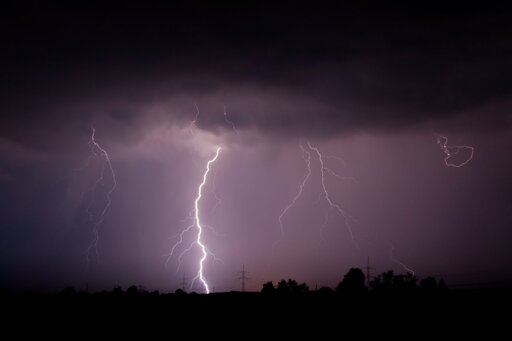Outdated lightning safety advice is making the rounds again, prompting experts to speak up about what actually keeps you safe in a storm.
If you get caught outdoors during a lightning storm, safety experts once recommended adopting a crouched position to lessen your chances of being struck by lightning. It turns out, however, that the position doesn’t make you any safer.
“If you’re caught outside during a thunderstorm, the best plan of action is to move as fast as you can to a safer place,” John Jensenius, a lightning safety specialist with the NLSC, said in a statement released by Loehr Lightning Protection Co. “The sooner you get to a safe place, the lower your risk. Crouching only prolongs the risk of being struck,” explained Jensenius.
The crouch isn’t just outdated—it was debunked almost 20 years ago. But despite the fact that the NLSC and the National Weather Service stopped recommending the crouch in 2008, institutions such as the American Hiking Society and the city of Bellmead in Texas continue to include it in their lightning safety guidelines.
The idea of the crouch is not really to be shorter than surrounding structures (maybe that is a minor aspect), but rather to reduce the step voltage (the voltage between your two feet). If you have only one point where you touch the ground, as you do when your feet are very close together, the risk of deadly currents passing through your body is minimised. This will of course not help you when the lightning strikes you directly, but that is not the most common case anyway. People usually die from the large current passing by their heart when they stand next to a lightning strike, and there is a distribution of electric potential across the ground. This is not a myth and not debunked. It’s just a matter of priorities. If there is safety nearby, you should obviously seek it out. If not, however, then to crouch is the best thing you can do.
I plan to bound my way to a safer place, like a two-legged gazelle, so that no more than one foot contacts the ground at any time.
Adopting a crouched position might not lessen your chances of being struck by lightning, but it does make it easier to kiss your ass goodbye.
If you’re caught outside during a thunderstorm, the best plan of action is to move as fast as you can to a safer place
institutions such as the American Hiking Society and the city of Bellmead in Texas continue to include it in their lightning safety guidelines.
A lot of times when hiking or backpacking, you may be hours from a safer place. In those cases, it probably is better to crouch than to try to run down a mountain during a thunderstorm.
The actual crouching to lower your height may not help much, but keeping your feet close together to minimize surface contact probably does help reduce your chances of dying to a nearby strike.
Keeping your feet close together makes zero difference, as what matters is the actual contact surface between you and the ground and not the area defined between your feet. Ideally you should reduce that to zero, but humans are not generally known for their ability ro hover in midair.
The most common cause of deaths from lightning is from ground current, where lightning travels through the ground, goes up one leg, and back down the other leg back into the ground. My understanding on it is that different parts of the ground have different conductivity, and if your feet are on patches of ground with different charge levels the lightning can go through your legs as the most conductive path between the two points. For similar reasons, I was once told that the safest way to move across the ground near a downed power pole (if you absolutely had to for some reason) was either to shuffle your feet while keeping them as close together as possible, or to hop on one foot.
That actually makes sense. I wouldn’t hop on one foot, though. That increases the odds of falling flat.
I’m sure it follows logic along the lines of “everyone I know has been following the crouching guidelines their entire life, and none of them have been struck, so it must work!”
Or like “if I duck lower than a fence pole than the lightning strikes the fence pole.” But it’s a conductivity thing, an open field of wet grass is a crappy situation.
Would lying flat and wriggling your way to safety like a big wet human worm help? Or always traveling with a taller, damper friend?
Lying flat, especially with a wet contact to the ground is about the worst you can do. Especially in tne mountains, where voltage gradients reach much farther from the point of the strike.
It is true that lightning is much more likely to strike a fence pole, but it is also true that being near a fence pole which gets gets struck is still extremely dangerous, as the main plasma channel will arc to other things in the area, and just generally creates a massive, dangerous electric field which extends out for several meters.
The crouching guidelines were never about avoiding being stuck, rather about reducing harm if you are incapable of reaching a safer location.
None of them have likely won Lotto either, but they don’t stop playing.
I was taught to find the lowest point and crouch, if I’m in the open field with nowhere else to go.
I don’t ever recall someone telling me to do it instead of finding cover.
yeah, ive had to do it for a fairly long time because I was near or above the tree line. not much shelter nearby, so squats it is.
If you’re the tallest surrounding structure, you’re the lightning rod
Technically true, but there’s other factors:
- Even if you’re crouched, you may still be the tallest structure (e.g. you’re in a big, open field).
- As the NLSC states, crouching prolongs the amount of time you’re in danger with little benefit over running to safety (I suppose if there is no safety, it’s better than nothing, and the CDC guidance does list this basically as a “last resort”).
- Even if there’s a taller structure near you (crouched or not), lightning causes electric currents along the top of the ground that can be deadly more than 100 feet away from the strike point.
Height has basically nothing to do with it - it’s the accumulation of static charge in a conductor which produces the dielectric breakdown of air. Even though the human body is a relatively poor conductor, it is still a much better conductor than the ground itself. It makes no difference if your head is 6 feet above the ground or three feet above the ground - you will accumulate charge the same way.
Also most strikes on people are not direct strikes, but people being close enough to to the primary plasma channel to provide another path to ground. The electric potential required to produce an arc from 5 feet away is orders of magnitude lower than it is from 3 miles up.
Also most strikes on people are not direct strikes
That’s the very reason why it is indeed helpful to crouch when there is no safety nearby. Putting your feet close together reduces the step voltage (the voltage across your feet), making it less likely that a deadly current flows through your heart when there are strong potentials on the ground.
What if you are wearing wool socks on a copper walkway?










